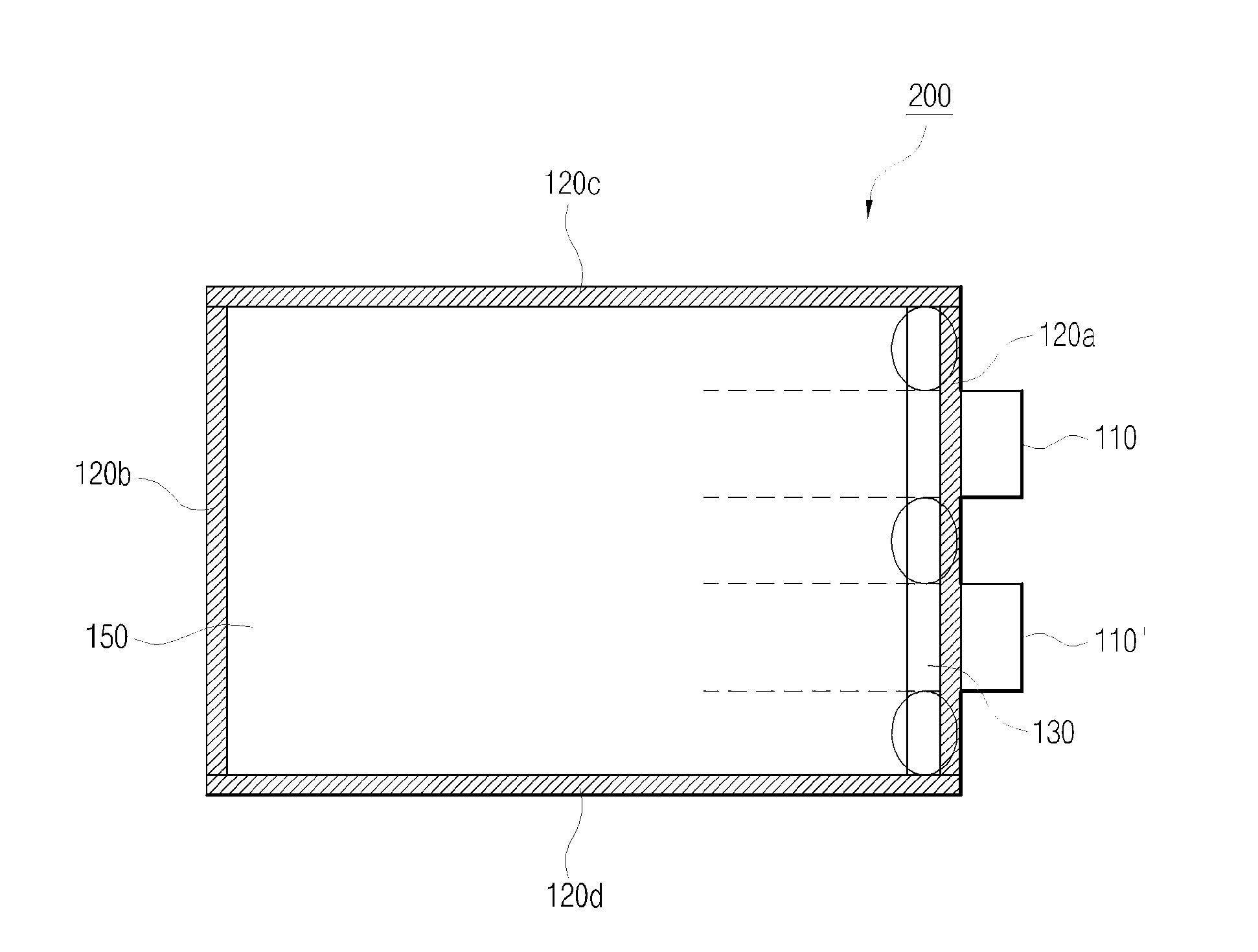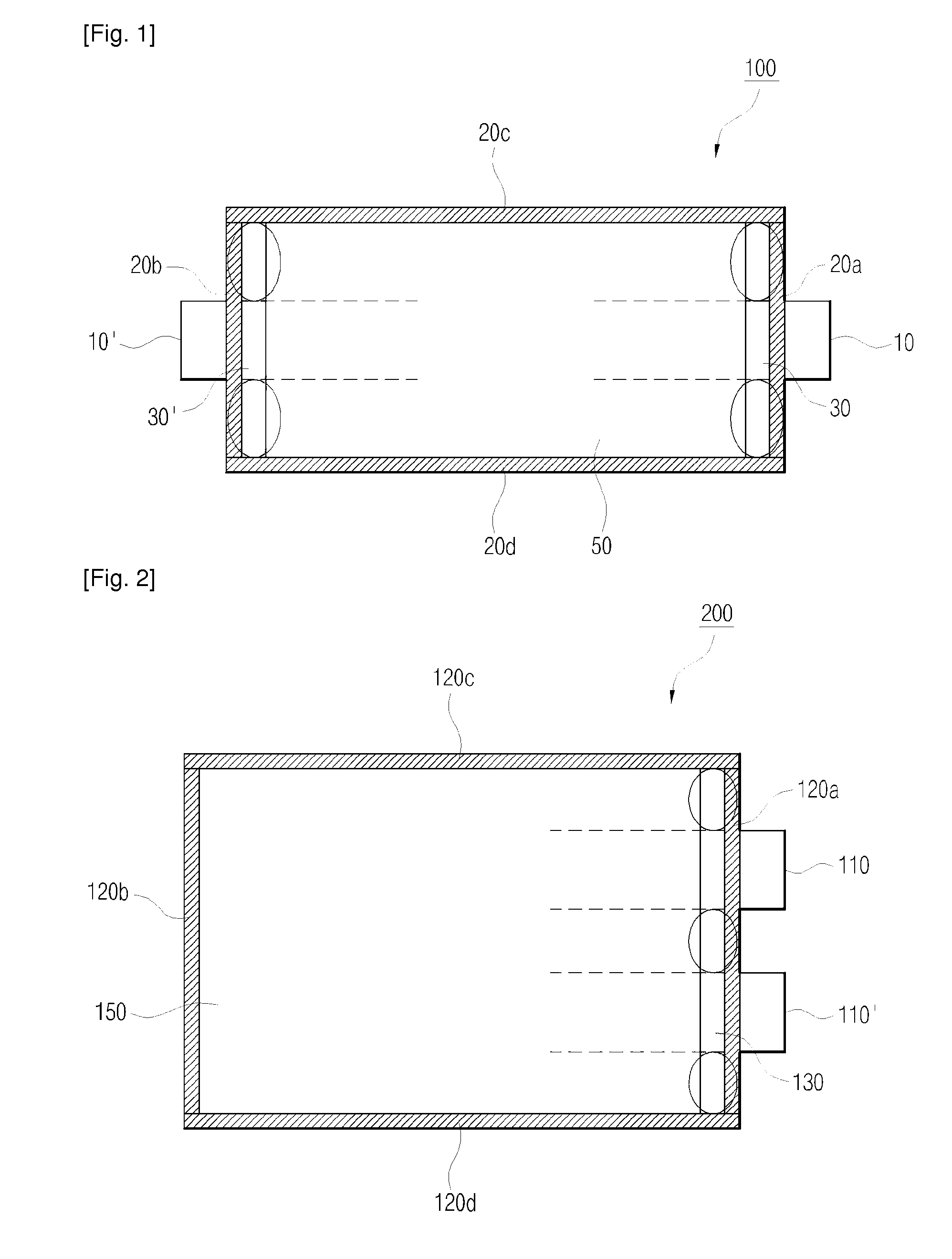Pouch type secondary battery with improved safety
a secondary battery and pouch-type technology, applied in the direction of cell sealing materials, cell components, cell cases/jackets, etc., can solve the problems of pouch-type secondary batteries being susceptible to internal short circuit risk, lithium secondary batteries may undergo explosion, and no sealing in the inside portions, so as to facilitate the design of safer battery packs and safety devices, the effect of improving safety
- Summary
- Abstract
- Description
- Claims
- Application Information
AI Technical Summary
Benefits of technology
Problems solved by technology
Method used
Image
Examples
example 1
Fabrication of a Secondary Battery Having Second Sealing Portions in a Structure including Electrode Tabs Formed on Both Sides of the Battery
[0043]A negative electrode tab of a 0.3 mm-thick copper was prepared which is attached to a negative collector of an electrode assembly consisting of a negative electrode / separator / positive electrode. Then, aluminum foil (for a positive electrode lead) and copper foil (for a negative electrode lead) were respectively welding-attached to the corresponding electrode tabs. Next, as shown in FIGS. 5 and 6, a secondary battery with formation of second sealing portions (250±20 μm) was fabricated with modification of a sealing tool. The electrode assembly was placed in a pouch-type case made of an aluminum laminate sheet, and a carbonate-based lithium electrolyte containing 1M LiPF6 was then injected thereto, followed by thermal fusion of the sheet to fabricate a lithium ion polymer battery.
example 2
Fabrication of a Secondary Battery Having Second Sealing Portions in a Structure including Electrode Tabs Formed on Either Side of the Battery
[0044]A lithium ion polymer battery was fabricated in the same manner as in Example 1, except that second sealing portions (250±20 μm) were formed with modification of a sealing tool, as shown in FIG. 7.
experimental example 1
[0046]Safety of the secondary batteries fabricated in Examples 1 and 2 and Comparative Example 1 was measured. The results thus obtained are given in Table 1 below.
TABLE 1Comparative Example 1Examples 1 and 2Vent directionVenting of gases atVenting of gases tosides of cellelectrode tabs
[0047]From the results of Table 1, it can be seen that formation of second sealing portions as in the present invention resulted in venting of gases to the electrode tabs, whereas no installation of second sealing portions as in Comparative Example 1 resulted in venting of gases in the non-uniform direction and toward a weak sealing part.
PUM
| Property | Measurement | Unit |
|---|---|---|
| thickness | aaaaa | aaaaa |
| thickness | aaaaa | aaaaa |
| thickness | aaaaa | aaaaa |
Abstract
Description
Claims
Application Information
 Login to View More
Login to View More - R&D
- Intellectual Property
- Life Sciences
- Materials
- Tech Scout
- Unparalleled Data Quality
- Higher Quality Content
- 60% Fewer Hallucinations
Browse by: Latest US Patents, China's latest patents, Technical Efficacy Thesaurus, Application Domain, Technology Topic, Popular Technical Reports.
© 2025 PatSnap. All rights reserved.Legal|Privacy policy|Modern Slavery Act Transparency Statement|Sitemap|About US| Contact US: help@patsnap.com



